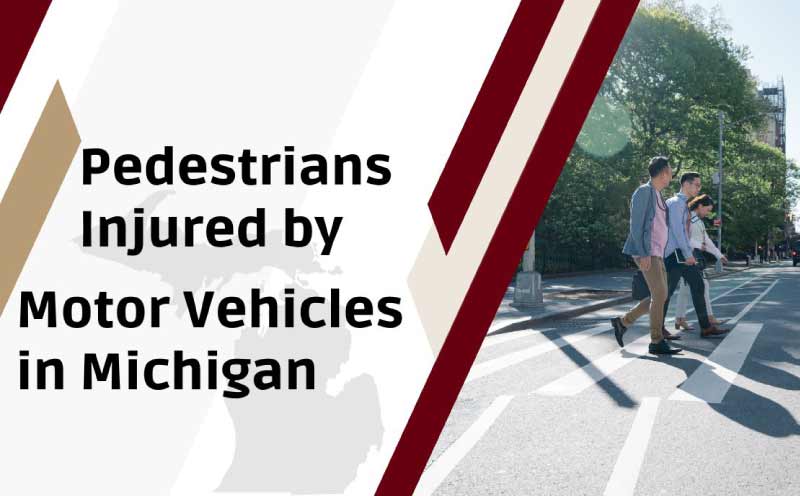Michigan Pedestrian Accidents: What to Know About Your Rights

The unfortunate truth is that the number of pedestrians involved in motor vehicle crashes is on the rise, and over 80% of the time the pedestrian is either seriously injured or killed. In Michigan, more than a hundred pedestrians are killed each year. There are a lot of things to keep in mind when it comes to being a pedestrian. It’s important to do everything you can to stay safe, and know your rights if you’re injured in a crash. With more than 70 years in the personal injury business, Sinas Dramis Law Firm has handled many cases involving pedestrians and motor vehicles. Below are some of the most frequently asked questions, and important pieces of information everyone should understand about Michigan pedestrian accidents.
Can a pedestrian receive Michigan no-fault benefits even if they don’t have their own policy?
Yes. If you are walking down the road as a pedestrian and you’re hit by a motor vehicle, which by the way does not include a motorcycle, but if it’s a car, an SUV, or a truck, you’re going to be entitled to no-fault benefits. There can be some exceptions, but in general, you should assume that you have some rights to pursue. Those no-fault benefits include coverage for your medical expenses, your income loss, and also some household services.
What damages can Michigan pedestrians recover from the at-fault driver?
The first place to start is whether the person has no-fault insurance coverage. If they do, you then need to determine how much coverage they have for their medical expenses. If on the no-fault side of things they’re covered for life, they’re probably not going to have what we call an excess medical expense claim to pursue against the at-fault driver. If they have less than lifetime coverage or no no-fault coverage, they can pursue their uncovered medical expenses from the at-fault. The other one is your income loss which is not covered by no-fault insurance. First, you look at how much no-fault insurance covers, and if that coverage expires after three years and the person still has a disability, they can pursue their uncovered excess income loss from the at-fault driver. Additionally, they can recover pain and suffering damages if they satisfy certain rules where they’re making a claim against the at-fault driver for compensation for their loss of quality of life.
How do you determine negligence in a Michigan pedestrian case?
Negligence is a concept where we’re asking whether the parties involved used reasonable care at the time the incident occurred. So, when you’re considering the at-fault driver, you’re asking, did that driver use reasonable care in operating the motor vehicle? Part of that is whether the driver violated the Michigan Motor Vehicle Code. You then also look at the circumstances of how the crash occurred and any other facts or issues that could affect whether that driver could have said to have been using reasonable care or not. At the same time, you also have to look at the conduct of the pedestrian. Was the pedestrian comparatively negligent? This is the question that the law asks juries to consider. Meaning did the pedestrians somehow contribute to the crash? Was the pedestrian walking out in a roadway where there was not a crosswalk? Did the pedestrian jump out in front of the car? There are all kinds of issues you have to examine in terms of how the pedestrian was behaving to determine who has fault and who doesn’t.
What about the rights of pedestrians who are injured in a hit-and-run accident?
Pedestrians injured in hit-and-run accidents have the same rights as any other pedestrian, but the reality is that they have a harder time pursuing those rights because they don’t know who hit them. If you can’t identify the driver, you don’t know who to pursue claims against. Therefore if you have a truly unidentified hit-and-run driver, it’s going to come back to whether the pedestrian has uninsured or underinsured motorist coverage in their own auto policy that’s in their household. That would cover them for any damage they could have had against the at-fault driver because that’s what uninsured and underinsured motorist coverage does. It kicks in if the driver doesn’t have insurance or can’t be identified. If you’re going to pursue one of those claims, there are some strict timelines you have to follow regarding hit-and-run uninsured and underinsured claims. You must act fast. In those situations, getting a lawyer right away is advised.
Can the injured pedestrian recover uninsured and underinsured benefits?
An injured pedestrian may have the right to pursue uninsured and underinsured motorist coverage. It’s going to depend on their auto insurance policy, whether it provides coverage for the facts and circumstances of where they’re injured. There can also be the issue of a person living in a household where there’s a policy, but it’s not issued to them. The question is whether the policy covers them as well, even though it’s issued to some other relative or someone else they’re living within the household. The right can be there, but it’s going to depend on the facts and details and the insurance coverage available to the injured person.
What can Pedestrians and Drivers do to stay safe?
Pedestrians must:
- Use sidewalks whenever available.
- Obey traffic signals, signs, and markings.
- Cross streets at a corner, using traffic signals and crosswalks whenever possible.
- Face traffic and stay as far to the left as possible if traveling on the roadway.
Pedestrians should:
- Always stop at the edge of a parked car, curb, or vehicle before walking out into traffic.
- Look left-right-left before crossing a street and continue looking while crossing.
- Make eye contact with drivers prior to crossing roadways.
- Be visible: wear reflective clothing and lights at night and wear bright colors during the day.
- Never allow children under the age of 10 to cross the streets alone. Young children do not have the skills to accurately judge traffic risks.
Drivers must:
- Stop before entering the marked crosswalk limit line.
- Stop before entering the intersection if there is no crosswalk or limit line.
- Obey traffic signals, signs, and markings.
- Yield to pedestrians in crosswalks, intersections, and all traffic-controlled areas.
- Obey the posted speed limit.
Drivers should:
- Never pass vehicles stopped at a crosswalk. There may be people crossing who cannot be seen.
- Avoid distractions.
- Stay alert and take extra caution at intersections, especially when making turns.
- Make eye contact with pedestrians waiting to cross roadways.
- Be extremely careful when backing up, checking for pedestrians who may move into the path of the vehicle
Pedestrian Crashes Involving Motorcycles and how they’re Different from Motor Vehicles?
When a pedestrian is hit by a motorcycle, there are some major differences in how the case is managed. A motorcycle is not considered to be a motor vehicle under the Michigan no-fault insurance law. So in that situation, there would be no motor vehicle involved. Meaning you would not have the right to claim no-fault insurance benefits. The rights of the pedestrian would be governed by a negligence claim against the motorcyclist, assuming the motorcyclist was at-fault. In that situation, you can pursue not just your pain and suffering, but also your medical expenses from the motorcyclist. If you are hit by a motorcycle in a hit-and-run, there’s basically nothing available. It’s going to depend on whether you have coverage that would cover you like uninsured or underinsured motorist coverage for that type of crash.

